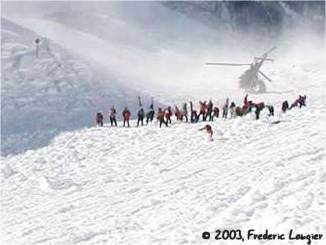I guess from the outcome that the evidence showed the ski party were in situ prior to the snowboard party entering higher ground, therefore the snowboarders course of travel showed a “...lack of care, negligence or security” and so put the skiers at fatal risk?
That’s a good comment and the whole case raises a number of issues.
The avalanche covered the open Crintiaux piste, in Frederic Laugier’s photo reportage you can see that the piste is covered to a good dpeth. Should the resort have opened the access to the sector given that an avalanche of this scale was possible?
The area is heavily used by off-piste skiers but maybe the guide had some responsibility, especially given the young age of his group to not take them where they were below other groups. Perhaps difficult these days in the Haute-Savoie/Savoie ski areas.
Without being 100% certain as I don’t have the police report to hand my understanding is that the snowboarders were climbing the ridge before the group started skiing the off-piste below, they may not even have been aware that people were on the ridge. An error by the guide, well he could reasonably sure that people would be using the ridge to access other off-piste as this is common practise.
This is a very big decision by the court, previously French courts have decided that where both groups are off-piste there is no legislation covering accidents.
Agreed. How does one modify their behaviour in response to this conviction? Primarily, my behaviour is constrained because I never want to cause someone’s death, but neither do I want to do something that can put me in prison. Prison is a deterrent. In the future I think I will stop moving every time someone crosses below my ascent route and is within the alpha angle run-out that they walked (were guided) into. Or perhaps I will just levitate one foot off the snow surface until they pass from risk. A risk that I did not put them in.
Telling is the number of tracks in those pictures of the bowl area. Just like many Haute Savoie resorts, it seems everyone was out for their bit of resort based off-piste fun that day and that at any stage one may have another person/party above or below them. That the avalanche hit the piste probably did not help the defendant’s cause. Perhaps the snowboarders should not have hiked the upper ridge knowing that directly below their higher route was a popular traverse line which was busy that day. They should have reasonably expected their actions to threaten those people randomly yet frequently passing below them on ‘safe’ well travelled terrain. But it appears all the boarders did was walk a little further up the ridge than the last party had already done. Where to draw the line? Perhaps don’t go higher than the off-piste area already tracked out. That isn’t practical as the lower easy to access areas always get tracked out first and, because we are in mountains, we naturally move upwards.
This is an unnerving decision. Having said that, I am expert in this topic nor French Law, and do not know the set of facts submitted as evidence. Of course, no disrespect to the young victim or her family is intended.
I am motivated by off-piste and back country touring and this legal precedent could be reason number 13 to stay away from resorts. There are too many people and too much natural and legal uncertainty in an environment that most participants assume is controlled.

